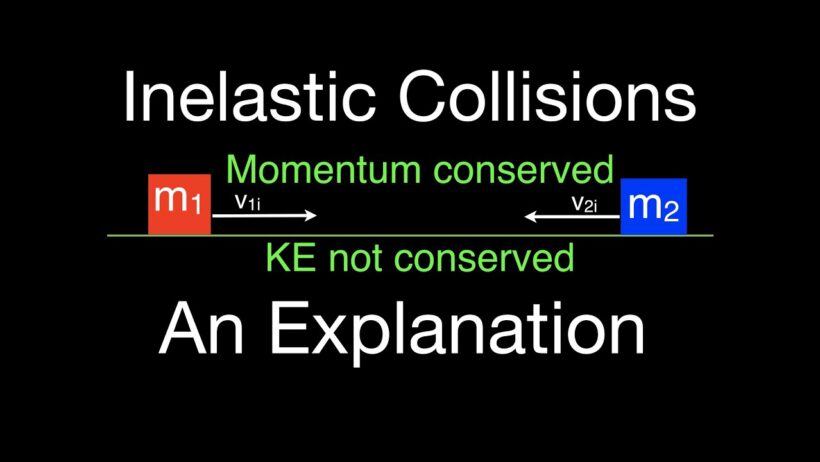In the realm of physics, collisions are examined under various classifications. Among these, elastic and inelastic collisions are notably distinct in their behavioral characteristics concerning momentum and energy. The inquiry into whether an inelastic collision conserves energy—beyond the steadfast conservation of momentum—demands attention to fundamental principles and their implications.
To grasp the essence of inelastic collisions, it is imperative first to delineate the parameters that define them. An inelastic collision occurs when two or more bodies collide and subsequently adhere to one another, leading to a combined mass that moves with a shared velocity post-collision. This phenomenon is contrary to elastic collisions, where bodies rebound away from each other, preserving both kinetic energy and momentum.
In order to explore the mechanics of inelastic collisions, it is essential to revisit the law of conservation of momentum. This law states that the total momentum of an isolated system remains constant when subjected solely to internal forces. In the context of an inelastic collision, the momentum before the impact equals the momentum after, allowing physicists to derive significant insights about the nature of the interaction.
Mathematically, this can be expressed as:
m1v1 + m2v2 = (m1 + m2)vf
Here, m1 and m2 represent the masses of the colliding bodies, v1 and v2 their respective velocities prior to collision, and vf the shared final velocity after impact. Notably, this equation holds true irrespective of whether the collision is elastic or inelastic.
However, delving into the conservation of energy unveils a more complex narrative. Unlike momentum, mechanical energy is generally not conserved in inelastic collisions. The transformation of energy manifests primarily through conversion into other forms, most notably thermal energy, which dissipates as heat during the collision. The kinetic energy that was possessed before impact is thus diminished in the aftermath, leading to an intriguing question: what happens to the energy?
The total kinetic energy before the collision can be articulated as:
KEinitial = 1/2 m1 v12 + 1/2 m2 v22
Upon collision, the kinetic energy is transformed in such a manner:
KEfinal = 1/2 (m1 + m2) vf2
The deviation of KEfinal from KEinitial reveals the lost energy. This discrepancy elucidates the transition from mechanical energy into thermal energy, sound energy, or deformation of the colliding bodies themselves.
For instance, consider a vehicle crash, a quintessential example of an inelastic collision. The kinetic energy of the vehicles prior to impact is not stored or recovered post-collision. Instead, it manifests as crumpled metal, heat generation, and noise. Such concepts not only illustrate the theoretical principles but invoke resonance with real-world ramifications, urging contemplation of energy conservation in everyday occurrences.
As a vital investigation narrows our understanding of inelastic collisions, one must ponder the implications of energy dissipation and its relationship with the environment. The kinetic energy transformed into undesirable forms such as heat and sound further exacerbates the tension between energy consumption and climate change. Energy efficiency emerges as a compelling challenge for contemporary society, juxtaposed against the backdrop of everyday phenomena such as vehicular transport.
Moreover, understanding energy transformations during inelastic collisions can foster innovation in technology. Engineers striving to enhance safety in automobiles can utilize this knowledge to design crumple zones effectively. These zones absorb impact energy, optimizing the safety of passengers while concurrently converting kinetic energy into less harmful forms during a collision.
In pursuit of a sustainable future, the broader implications of these principles extend into the realms of environmental conservation and climate mitigation. Understanding the nuances of energy transformation can galvanize the pursuit of technologies that prioritize reduced energy loss and enhanced efficiency. Exploring avenues such as regenerative braking in electric vehicles exemplifies how an acute awareness of energy dynamics can yield mechanisms to harvest kinetic energy and convert it back to usable electrical energy.
The transformation of energy during inelastic collisions is emblematic of a broader narrative. It underscores the duality of momentum conservation alongside energy dissipation, revealing fundamental truths that mold our understanding of the physical world. It presents a categorical imperative to redesign our technological infrastructures and develop innovations that echo these principles, driving us toward sustainability and efficacy.
In conclusion, while momentum remains preserved through the mechanics of inelastic collisions, energy takes on a more convoluted role, being transformed into various other forms, primarily thermal and sound energy. As society grapples with the pressing realities of climate change and energy demands, an astute understanding of these phenomena can impel innovation and efficiency. By shifting our perspective and nurturing curiosity about the science that underlies daily interactions, we can contribute meaningfully to a more sustainable future.




